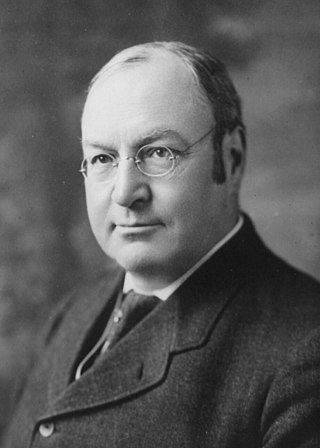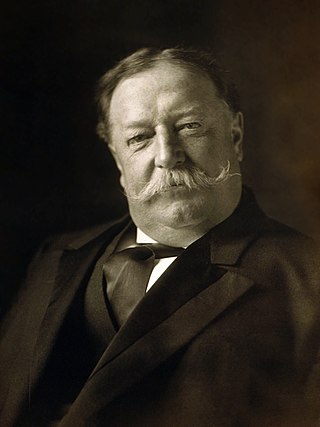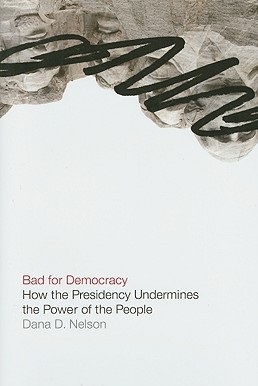
The president of the United States (POTUS) is the head of state and head of government of the United States of America. The president directs the executive branch of the federal government and is the commander-in-chief of the United States Armed Forces.

The Constitution of the United States is the supreme law of the United States. It superseded the Articles of Confederation, the nation's first constitution, on March 4, 1789. Originally including seven articles, the Constitution delineates the national frame and constrains the powers of the federal government. The Constitution's first three articles embody the doctrine of the separation of powers, in which the federal government is divided into three branches: the legislative, consisting of the bicameral Congress ; the executive, consisting of the president and subordinate officers ; and the judicial, consisting of the Supreme Court and other federal courts. Article IV, Article V, and Article VI embody concepts of federalism, describing the rights and responsibilities of state governments, the states in relationship to the federal government, and the shared process of constitutional amendment. Article VII establishes the procedure subsequently used by the 13 states to ratify it. The Constitution of the United States is the oldest and longest-standing written and codified national constitution in force in the world.

William Howard Taft was the 27th president of the United States, serving from 1909 to 1913, and the tenth chief justice of the United States, serving from 1921 to 1930, the only person to have held both offices. Taft was elected president in 1908, the chosen successor of Theodore Roosevelt, but was defeated for reelection in 1912 by Woodrow Wilson after Roosevelt split the Republican vote by running as a third-party candidate. In 1921, President Warren G. Harding appointed Taft to be chief justice, a position he held until a month before his death.

James Schoolcraft Sherman was an American politician who was a United States representative from New York from 1887 to 1891 and 1893 to 1909, and the 27th vice president of the United States under President William Howard Taft from 1909 until his death in 1912. He was a member of the interrelated Baldwin, Hoar, and Sherman families, prominent lawyers and politicians of New England and New York.
Myers v. United States, 272 U.S. 52 (1926), was a United States Supreme Court decision ruling that the President has the exclusive power to remove executive branch officials, and does not need the approval of the Senate or any other legislative body. It was distinguished in 1935 by Humphrey's Executor v. United States. However, in Seila Law LLC v. Consumer Financial Protection Bureau (2020), the Supreme Court interpreted Myers as establishing that the President generally has unencumbered removal power. Myers was the first Supreme Court case to address the president's removal powers.

The oath of office of the president of the United States is the oath or affirmation that the president of the United States takes upon assuming office. The wording of the oath is specified in Article II, Section One, Clause 8, of the United States Constitution, and a new president must take it before exercising or carrying out any official powers or duties.
The powers of the president of the United States include those explicitly granted by Article II of the United States Constitution as well as those granted by Acts of Congress, implied powers, and also a great deal of soft power that is attached to the presidency.
The unitary executive theory is a legal theory in United States constitutional law which holds that the President of the United States possesses the power to control the entire federal executive branch. The doctrine is rooted in Article Two of the United States Constitution, which vests "the executive Power" of the United States in the President.
Censure is a formal, public, group condemnation of an individual, often a group member, whose actions run counter to the group's acceptable standards for individual behavior. In the United States, governmental censure is done when a body's members wish to publicly reprimand the president of the United States, a member of Congress, a judge or a cabinet member. It is a formal statement of disapproval. It relies on the target's sense of shame or their constituents' subsequent disapproval, without which it has little practical effect when done on members of Congress and no practical effect when done on the president.
Dollar diplomacy of the United States, particularly during the presidency of William Howard Taft (1909–1913) was a form of American foreign policy to minimize the use or threat of military force and instead further its aims in Latin America and East Asia through the use of its economic power by guaranteeing loans made to foreign countries. In his message to Congress on 3 December 1912, Taft summarized the policy of Dollar diplomacy:

The presidency of William Howard Taft began on March 4, 1909, when William Howard Taft was inaugurated as 27th president of the United States, and ended on March 4, 1913. Taft was a Republican from Ohio. The protégé and chosen successor of President Theodore Roosevelt, he took office after easily defeating Democrat William Jennings Bryan in the 1908 presidential election. His presidency ended with his defeat in the 1912 election by Democrat Woodrow Wilson.
Since the Great Depression, Rhode Island politics have been dominated by the Rhode Island Democratic Party, and the state is considered part of the Democrats' "Blue Wall." Democrats have won all but four presidential elections since 1928, with the exceptions being 1952, 1956, 1972, and 1984. The Rhode Island Republican Party, although virtually non-existent in the Rhode Island General Assembly, has remained competitive in gubernatorial elections, having won one as recently as 2006. Until 2014, Democrats had not won a gubernatorial election in the state since 1992, and it was not until 2018 that they won one by double digits. The Rhode Island General Assembly has continuously been under Democratic control since 1959.

Bad for Democracy: How the Presidency Undermines the Power of the People (2008) is a non-fiction book written by Vanderbilt professor Dana D. Nelson. It is notable for its criticism of excessive presidential power and for her call for substantive political reform. Nelson's focus is not on particular presidents, but she argues that the office of the presidency itself "endangers the great American experiment."

The history of the United States Congress refers to the chronological record of the United States Congress including legislative sessions from 1789 to the present day. It also includes a brief history of the Continental Congress from 1774 through 1781 and the Congress of the Confederation from 1781 to 1789.

The 1900 United States presidential election in Virginia took place on November 6, 1900, as part of the 1900 United States presidential election. Voters chose 12 representatives, or electors to the Electoral College, who voted for president and vice president.
The following are some of the books and papers which have been written concerning William Howard Taft, the 27th president of the United States:
Ex parte Grossman, 267 U.S. 87 (1925), was a US Supreme Court case that held that the US President may pardon criminal contempt of court. Grossman had been convicted of criminal contempt but was pardoned by the President. The district court subsequently sent him back to prison.
The Decision of 1789 refers to a month-long constitutional debate that occurred during the first session of the United States House of Representatives as to whether Article Two of the United States Constitution granted the president the power to remove officers of the United States at will. It has been called "the first significant legislative construction of the Constitution". The debate centered around "a bill that would create a Department of Foreign Affairs"—the precursor to the Department of State—and which branch of government would have the power to remove officers from that department.
The presidency of William Howard Taft began on March 4, 1909, when William Howard Taft was inaugurated the 27th president of the United States and ended on March 4, 1913.










